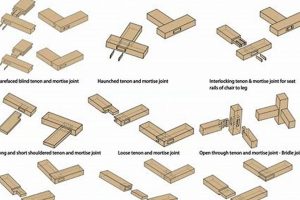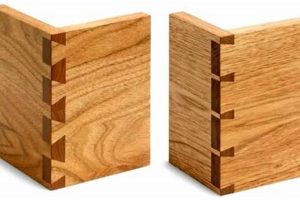
The methods by which separate pieces of wood are connected to create a larger, unified structure constitute a critical aspect of woodworking. These connections, relying on techniques of joinery, range from simple... Read more »

An element within the connection of two or more pieces of wood contributes to the overall strength and stability of the assembled structure. These components are meticulously shaped and fitted to interlock,... Read more »

This particular method, often admired for both its structural integrity and visual appeal, involves inserting a shaped piece of wood across a joint to reinforce and stabilize it. The insert, typically wider... Read more »

A woodworking technique, this joint connects two pieces of material lengthwise, creating a longer single piece. Characterized by angled or beveled mating surfaces, it maximizes the gluing area and distributing stress along... Read more »

A method of joining two pieces of wood edge-to-edge, this technique creates a seamless and visually appealing connection, often employed when greater width is required than a single board offers. It involves... Read more »

The answer to a puzzle prompt referencing the connection of wooden elements often describes a specific type of joinery. This joinery involves techniques used to unite two or more pieces of timber,... Read more »

A technique employed in woodworking creates a robust and visually appealing connection between two pieces of material. This method involves shaping one component to conform precisely to the curved or contoured surface... Read more »

Implements utilized in the creation of connections between pieces of lumber are essential for constructing stable and aesthetically pleasing wooden structures. These devices range from hand-operated varieties, like chisels and saws, to... Read more »

A method of joining two pieces of wood together, characterized by interlocking projections resembling a bird’s tail. These projections, cut into one board, fit precisely into corresponding recesses in the other, creating... Read more »

A recessed channel or step cut along the edge of a piece of material, typically wood, creates a surface for joining with another piece. This technique provides a strong and straightforward method... Read more »


